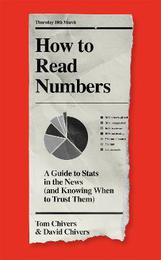
|
How to Read Numbers: A Guide to Statistics in the News (and Knowing When to Trust Them)
Hardback
Main Details
| Title |
How to Read Numbers: A Guide to Statistics in the News (and Knowing When to Trust Them)
|
| Authors and Contributors |
By (author) Tom Chivers
|
|
By (author) David Chivers
|
| Physical Properties |
| Format:Hardback | | Pages:208 | | Dimensions(mm): Height 222,Width 142 |
|
| Category/Genre | Mathematics
Probability and statistics
Applied mathematics
Popular science |
|---|
| ISBN/Barcode |
9781474619967
|
| Classifications | Dewey:519.5 |
|---|
| Audience | | Tertiary Education (US: College) | | Professional & Vocational | | General | |
|---|
|
Publishing Details |
| Publisher |
Orion Publishing Co
|
| Imprint |
Weidenfeld & Nicolson
|
| Publication Date |
18 March 2021 |
| Publication Country |
United Kingdom
|
Description
'Even one glass of wine a day raises the risk of cancer' 'Hate crimes have doubled in five years' 'Fizzy drinks make teenagers violent' Every day, most of us will read or watch something in the news that is based on statistics in some way. Sometimes it'll be obvious - 'X people develop cancer every year' - and sometimes less obvious - 'How smartphones destroyed a generation'. Statistics are an immensely powerful tool for understanding the world; the best tool we have. But in the wrong hands, they can be dangerous. This book will help you spot common mistakes and tricks that can mislead you into thinking that small numbers are big, or unimportant changes are important. It will show you how the numbers you read are made - you'll learn about how surveys with small or biased samples can generate wrong answers, and why ice cream doesn't cause drownings. We are surrounded by numbers and data, and it has never been more important to separate the good from the bad, the true from the false. HOW TO READ NUMBERS is a vital guide that will help you understand when and how to trust the numbers in the news - and, just as importantly, when not to.
Author Biography
Tom Chivers is a science writer and author. He was awarded the Royal Statistical Society 'statistical excellence in journalism' award in 2018, and was highly commended for the same prize in 2017; he has also been shortlisted for the Association of British Science Writers award and a British Journalism Award in science writing, and won the American Psychological Society media award, all in 2017. His first book, The AI Does Not Hate You: Superintelligence, Rationality and the Race to Save the World, was declared one of The Times' science books of 2019. David Chivers is an assistant professor of economics at Durham University. Before this post he was a lecturer at the University of Oxford and completed his PhD at the University of Manchester, funded by the ESRC. He has published in academic journals such as Review of Economic Dynamics, Economic Theory and Journal of Economic Behaviour and Organisation. His research interests involve topics relating to inequality, growth and development.
ReviewsA charming, practical and insightful guide. You might not even notice how much you're learning - you'll be too busy having fun -- TIM HARFORD, author of HOW TO MAKE THE WORLD ADD UP A vital plea to take statistics more seriously - the prose being as clear and elegant as the numbers -- SATHNAM SANGHERA, author of EMPIRELAND Reading this book is strongly correlated with not looking stupid. Highly recommended -- HELEN LEWIS, author of Difficult Women An excellent guide to everyday statistics . . . the authors do a splendid job of stringing words together so smartly that even difficult concepts are explained and so understood with ease. [A] timely and lively book -- Manjit Kumar * THE TIMES * Wonderfully written - incredibly readable. It should be made compulsory reading for everyone before they leave school -- EVAN DAVIS An erudite, enlightening guide to the numbers we read in the news - and why they are so often wrong. The authors make sense of dense material and offer engrossing insights into sampling bias, statistical significance and the dangers of believing the casual language used in newspapers * INDEPENDENT * [A] fascinating, easy-to-read explanation of how to interpret numbers in the news . . . their enlightening book provides us with the tools to spot when we're being led astray -- Nick Rennison * DAILY MAIL * An absolute lifesaver . . . Breezy, easy to read, funny and loaded with useful information -- IAN DUNT, author of HOW TO BE A LIBERAL A great combination of important and accessible -- MISHAL HUSAIN Brilliant . . . part of the joy of How to Read Numbers is how light and fun it is. At the end of the process, you'll be better equipped to understand what it means when a glass of red wine can both increase and decrease your chances of getting cancer, how many portions of fruit and veg you need to eat each day, and any number of stories about numbers you might read or hear * THE BIG ISSUE *
|